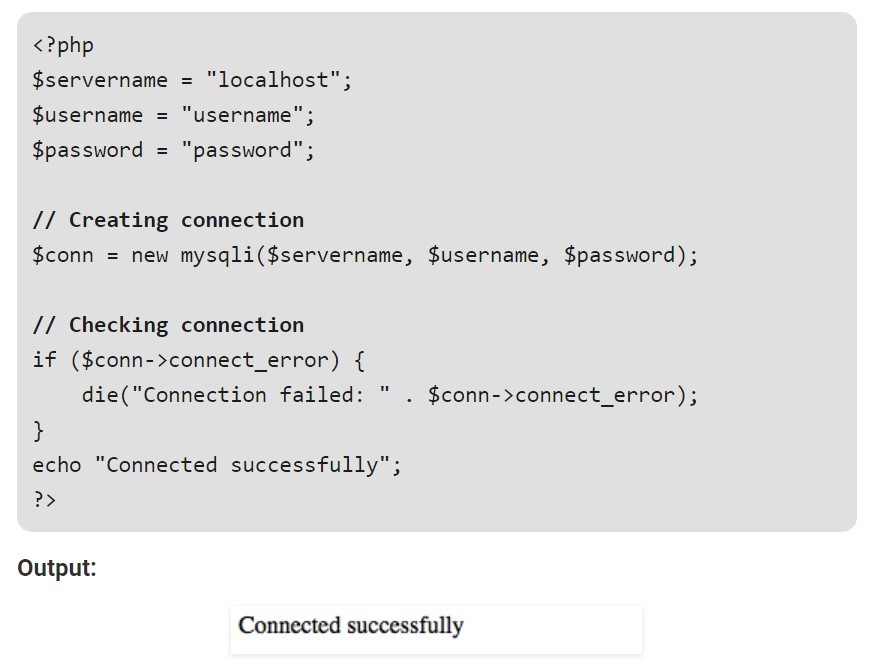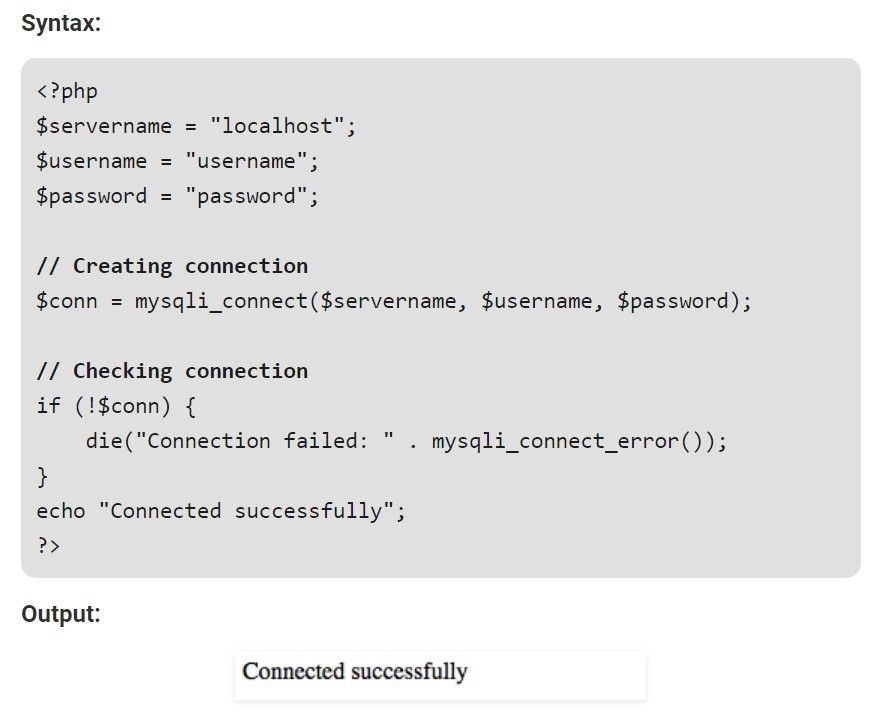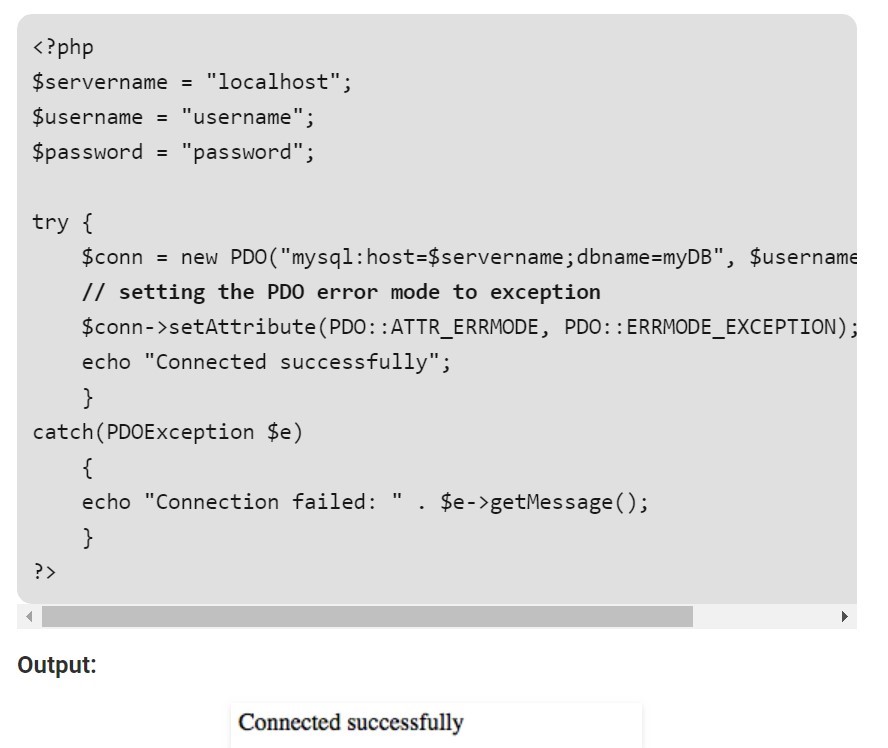To make optimum usage of any database, one should be able to manipulate it as required. The best way to manipulate and manage the databases you created is to connect your database with PHP. First, let us understand what PHP is. PHP is like a control panel that can be used to manage your database. Connecting to PHP allows you to retrieve data from databases as needed for a particular query. MySQL is the most popular open-source RDBMS, which can be easily connected to PHP. MySQL organizes data in tables using a row and column structure. As a result, MySQL is suitable for both small and large applications, and it operates on the server.
ADVERTISEMENT Popular Course in this category PHP DEVELOPER - Specialization | 8 Course Series | 3 Mock TestsStart Your Free Software Development Course
Web development, programming languages, Software testing & others
How to Create a Database?
Creating a database in MySQL is as simple as performing a single command in SQL. For example, an easy query of “[CREATE DATABASE]” can be used for database creation for beginners. Another database creation option is using another query as “[CREATE SCHEMA].”
For instance, if you wish to create a database named “movies,” you can achieve this by executing the command CREATE DATABASE movies;

Adding more parameters and avoiding confusion between existing databases on a single MySQL server can use the command “[IF NOT EXISTS].” This query checks whether any existing database has the same name. If yes, the command will not execute the creation of the database. On the other hand, if there is no such conflict of database names, the below command will execute and create a database. Although “[IF NOT EXISTS]” is non-mandatory, it is a good practice.

This newly created database will be empty, waiting for the inclusion of tables with data. SQL command for tables is a simple query “[CREATE TABLE]” with syntax as below.
This newly created database will be empty, waiting for the inclusion of tables with data. SQL command for tables is a simple query “[CREATE TABLE]” with syntax as below.

Connecting Database to PHP
PHP versions below 5 use MySQL extension. But this extension was derogated in 2012.
The 5th version of PHP and newer versions can work with below:
1. MySQLi extension
2. PDO (PHP Data Objects)
According to their own supremacy and needs, any of the above options can be utilized.
The MySQLi extension can be used only with MySQL databases, whereas PDO can connect with 12 different database systems. So, PDO might be helpful if one is switching databases as it only requires changing a few connections. But in the case of MySQLi, we need to write the entire code and query to switch databases. Enabling MySQLi on PHP is necessary to work with MySQLi. MySQLi also provides a procedural programming interface along with an object-oriented one. PDO and MySQLi support prepared statements, which are crucial aspects of web security.
Working with PHP and MySQL
PHP and MySQL are some of the most common stacks for web development.
- Object-oriented MySQLi
- Procedural MySQLi
- PDO
To start with any of these, you must know some essential details, such as your database system’s server address, username, database name, and password. Mainly, we will be using mysqli_connect in all three procedures. This command sets up a connection between the database and PHP. First of all, we have to create a separate connection file. This saves time in writing code every time you want to insert data and information from the database and insert this data in multiple files.
We can use the PHP file connection name along with the include function and insert the data instead of rewriting the code each time. This is also useful when transferring your entire project from one system to another. When you change the values in one file, it automatically changes all values in every file and saves you the effort of making changes in every file. Once you have successfully established the connection, you can employ various methods to interact with the database.
Let’s look into each of them one by one:
1. Using Object-Oriented MySQLi
This can be used to build an association with the database using PHP script using the following syntax.

Explanation:
- Localhost is the location of the server. The host can be something else, but the server runs on the localhost in most cases.
- The username is the root, and the password; is the same which you use for php admin.
- To establish this link, provide the necessary details such as localhost, username, and password. This will create an instance of MySQLi, resulting in a successful connection.
2. Using MySQLi Procedural
To establish a connection between the database and PHP using MySQLi procedural, you can follow the procedure outlined below:

Explanation:
- The main difference for the procedural procedure is that it uses the function mysqli_connect, which fetches the necessary details of the host, username, and password, etc. When successfully connected, it will provide a link identifier.
3. Using PDO
PDO represents PHP Data objects. So in this process of creating a connection, PHP data objects are used as below:

Explanation:
- The exception function in PDO assists in throwing and handling any exceptions that may arise while establishing connections, ensuring proper management of any encountered issues.
All the above methods help access and manage the database you need.
Checking the Connection:
Below syntax can be used to check whether your connection is successfully connected.

Db_connection is the php file name.
Ending the Connection:
Once you establish a database connection using PHP scripts, you should close the connection once your work is finished. With an assumption of reference to the connection stored in the $ conn variable, below are the closing syntax used in the above-given procedures.
- Using MySQLi object-oriented procedure

- Using MySQLi procedural procedure

- Using PDO procedure

Conclusion – How to Connect Database to PHP?
Accessing and managing your database becomes straightforward when you establish a connection using PHP. It also offers a variety of ways to establish this connection to suit varying levels of requirements. After establishing the connection, you can actively execute queries to extract data from the tables. You can easily print out this information. Closing the connection is an essential part of connecting the database to PHP, and it should be done once your work is completed.
The above is the detailed content of How to Connect Database to PHP?. For more information, please follow other related articles on the PHP Chinese website!

Hot AI Tools

Undress AI Tool
Undress images for free

Undresser.AI Undress
AI-powered app for creating realistic nude photos

AI Clothes Remover
Online AI tool for removing clothes from photos.

Clothoff.io
AI clothes remover

Video Face Swap
Swap faces in any video effortlessly with our completely free AI face swap tool!

Hot Article

Hot Tools

Notepad++7.3.1
Easy-to-use and free code editor

SublimeText3 Chinese version
Chinese version, very easy to use

Zend Studio 13.0.1
Powerful PHP integrated development environment

Dreamweaver CS6
Visual web development tools

SublimeText3 Mac version
God-level code editing software (SublimeText3)

Hot Topics
 How do I stay up-to-date with the latest PHP developments and best practices?
Jun 23, 2025 am 12:56 AM
How do I stay up-to-date with the latest PHP developments and best practices?
Jun 23, 2025 am 12:56 AM
TostaycurrentwithPHPdevelopmentsandbestpractices,followkeynewssourceslikePHP.netandPHPWeekly,engagewithcommunitiesonforumsandconferences,keeptoolingupdatedandgraduallyadoptnewfeatures,andreadorcontributetoopensourceprojects.First,followreliablesource
 What is PHP, and why is it used for web development?
Jun 23, 2025 am 12:55 AM
What is PHP, and why is it used for web development?
Jun 23, 2025 am 12:55 AM
PHPbecamepopularforwebdevelopmentduetoitseaseoflearning,seamlessintegrationwithHTML,widespreadhostingsupport,andalargeecosystemincludingframeworkslikeLaravelandCMSplatformslikeWordPress.Itexcelsinhandlingformsubmissions,managingusersessions,interacti
 How to set PHP time zone?
Jun 25, 2025 am 01:00 AM
How to set PHP time zone?
Jun 25, 2025 am 01:00 AM
TosettherighttimezoneinPHP,usedate_default_timezone_set()functionatthestartofyourscriptwithavalididentifiersuchas'America/New_York'.1.Usedate_default_timezone_set()beforeanydate/timefunctions.2.Alternatively,configurethephp.inifilebysettingdate.timez
 How do I validate user input in PHP to ensure it meets certain criteria?
Jun 22, 2025 am 01:00 AM
How do I validate user input in PHP to ensure it meets certain criteria?
Jun 22, 2025 am 01:00 AM
TovalidateuserinputinPHP,usebuilt-invalidationfunctionslikefilter_var()andfilter_input(),applyregularexpressionsforcustomformatssuchasusernamesorphonenumbers,checkdatatypesfornumericvalueslikeageorprice,setlengthlimitsandtrimwhitespacetopreventlayout
 What is data serialization in PHP (serialize(), unserialize())?
Jun 22, 2025 am 01:03 AM
What is data serialization in PHP (serialize(), unserialize())?
Jun 22, 2025 am 01:03 AM
ThePhpfunctionSerialize () andunserialize () AreusedtoconvertcomplexdaTastructdestoresintostoraSandaBackagain.1.Serialize () c OnvertsdatalikecarraysorobjectsraystringcontainingTypeandstructureinformation.2.unserialize () Reconstruct theoriginalatataprom
 How do I embed PHP code in an HTML file?
Jun 22, 2025 am 01:00 AM
How do I embed PHP code in an HTML file?
Jun 22, 2025 am 01:00 AM
You can embed PHP code into HTML files, but make sure that the file has an extension of .php so that the server can parse it correctly. Use standard tags to wrap PHP code, insert dynamic content anywhere in HTML. In addition, you can switch PHP and HTML multiple times in the same file to realize dynamic functions such as conditional rendering. Be sure to pay attention to the server configuration and syntax correctness to avoid problems caused by short labels, quotation mark errors or omitted end labels.
 What are the best practices for writing clean and maintainable PHP code?
Jun 24, 2025 am 12:53 AM
What are the best practices for writing clean and maintainable PHP code?
Jun 24, 2025 am 12:53 AM
The key to writing clean and easy-to-maintain PHP code lies in clear naming, following standards, reasonable structure, making good use of comments and testability. 1. Use clear variables, functions and class names, such as $userData and calculateTotalPrice(); 2. Follow the PSR-12 standard unified code style; 3. Split the code structure according to responsibilities, and organize it using MVC or Laravel-style catalogs; 4. Avoid noodles-style code and split the logic into small functions with a single responsibility; 5. Add comments at key points and write interface documents to clarify parameters, return values ??and exceptions; 6. Improve testability, adopt dependency injection, reduce global state and static methods. These practices improve code quality, collaboration efficiency and post-maintenance ease.
 How do I execute SQL queries using PHP?
Jun 24, 2025 am 12:54 AM
How do I execute SQL queries using PHP?
Jun 24, 2025 am 12:54 AM
Yes,youcanrunSQLqueriesusingPHP,andtheprocessinvolveschoosingadatabaseextension,connectingtothedatabase,executingqueriessafely,andclosingconnectionswhendone.Todothis,firstchoosebetweenMySQLiorPDO,withPDObeingmoreflexibleduetosupportingmultipledatabas






